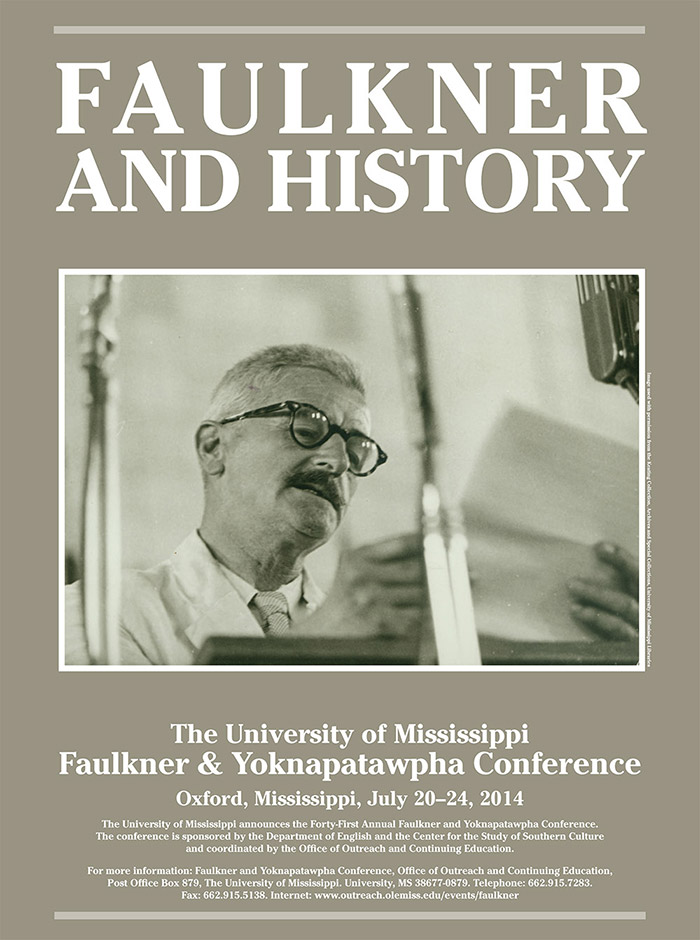
Panel. Faulkner in the History of Modernity
Location
Nutt Auditorium
Start Date
23-7-2014 9:30 AM
Description
- "Who Are You?": Modernism, Childhood, and Historical Consciousness in Faulkner's The Wishing Tree / Hannah Godwin, University of Oregon
This paper calls for a critical reevaluation of Faulkner’s little known children’s book, The Wishing Tree (1927), by identifying this curious text as a rich interpretive site for understanding modernist childhood[s]. Previous scholarship on The Wishing Tree traces its complex and fascinating textual history [Brodsky], identifies its potential merits and utility in the contemporary classroom [Hargrove], and acknowledges its significance as a testing ground for thematic preoccupations Faulkner later explores in his experimental modernist masterworks [Ditsky]. However, what remains missing from this critical conversation is a consideration of The Wishing Tree’s specific engagement with modernist constructions of children and childhood; interrogating this gap brings into relief Faulkner’s unique interest in problematizing dominant modernist representations of child consciousness and offers a fuller picture of the depth of his historical engagement. - Historicizing a Speed Demon: How Thomas Sutpen Drives Modernization in Faulkner's Absalom, Absalom! / Sara Gabler Thomas, University of Mississippi
Following the high modernism of The Sound and the Fury and As I Lay Dying, Faulkner turned towards a more complex investigation of time and history in Light in August, Absalom, Absalom! and Go Down, Moses, texts which I read as marking a distinctive phase in his effort to represent temporality. Of course the earlier high modernist Faulkner can (and has) been read temporally, but such analyses often focus on things like trauma, repetition, and involuntary memory—that is, on the representation of individual consciousness in the present. I argue that in these later temporal novels, Faulkner seeks to portray the metonymically present past, what the historical theorist Eelco Runia calls “the epiphanic moment in which historical reality stops being absently present in words and phrases and stands before us.” For me, this is a central (and paradoxical) task of Faulkner’s mature fiction: to represent the way the past remains present outside of representation. - The Motion and the Noise: Yoknapatawpha's Shifting Soundscape / Matthew Sutton, College of William and Mary
William Faulkner’s aversion to the “noise” of radios, phonographs and jukeboxes in Oxford is well documented. That aversion carries over most forcefully in Intruder in the Dust (1948), where the narration indicts the “cheap shoddy dishonest music” that has become commonplace in Jefferson’s old town square. Though perhaps unintentionally, Faulkner captures the democratization of midcentury popular culture through his condemnations of sounds that are “out of place” in spaces dominated by Jim Crow. By juxtaposing Intruder’s descriptions of “the motion and the noise” with contemporary accounts of music’s liberating potential for African Americans, this paper will interpret a transformative period in the soundscape of Yoknapatawpha. Both in fiction and in fact, the “noise” of late-1940s Mississippi heralded social changes arriving much faster than Faulkner and other gradualists desired.
Relational Format
Conference proceeding
Recommended Citation
Godwin, Hannah; Thomas, Sara Gabler; and Sutton, Matthew, "Panel. Faulkner in the History of Modernity" (2014). Faulkner and Yoknapatawpha Conference. 22.
https://egrove.olemiss.edu/fy/2014/schedule/22
COinS
Jul 23rd, 9:30 AM
Panel. Faulkner in the History of Modernity
Nutt Auditorium
- "Who Are You?": Modernism, Childhood, and Historical Consciousness in Faulkner's The Wishing Tree / Hannah Godwin, University of Oregon
This paper calls for a critical reevaluation of Faulkner’s little known children’s book, The Wishing Tree (1927), by identifying this curious text as a rich interpretive site for understanding modernist childhood[s]. Previous scholarship on The Wishing Tree traces its complex and fascinating textual history [Brodsky], identifies its potential merits and utility in the contemporary classroom [Hargrove], and acknowledges its significance as a testing ground for thematic preoccupations Faulkner later explores in his experimental modernist masterworks [Ditsky]. However, what remains missing from this critical conversation is a consideration of The Wishing Tree’s specific engagement with modernist constructions of children and childhood; interrogating this gap brings into relief Faulkner’s unique interest in problematizing dominant modernist representations of child consciousness and offers a fuller picture of the depth of his historical engagement. - Historicizing a Speed Demon: How Thomas Sutpen Drives Modernization in Faulkner's Absalom, Absalom! / Sara Gabler Thomas, University of Mississippi
Following the high modernism of The Sound and the Fury and As I Lay Dying, Faulkner turned towards a more complex investigation of time and history in Light in August, Absalom, Absalom! and Go Down, Moses, texts which I read as marking a distinctive phase in his effort to represent temporality. Of course the earlier high modernist Faulkner can (and has) been read temporally, but such analyses often focus on things like trauma, repetition, and involuntary memory—that is, on the representation of individual consciousness in the present. I argue that in these later temporal novels, Faulkner seeks to portray the metonymically present past, what the historical theorist Eelco Runia calls “the epiphanic moment in which historical reality stops being absently present in words and phrases and stands before us.” For me, this is a central (and paradoxical) task of Faulkner’s mature fiction: to represent the way the past remains present outside of representation. - The Motion and the Noise: Yoknapatawpha's Shifting Soundscape / Matthew Sutton, College of William and Mary
William Faulkner’s aversion to the “noise” of radios, phonographs and jukeboxes in Oxford is well documented. That aversion carries over most forcefully in Intruder in the Dust (1948), where the narration indicts the “cheap shoddy dishonest music” that has become commonplace in Jefferson’s old town square. Though perhaps unintentionally, Faulkner captures the democratization of midcentury popular culture through his condemnations of sounds that are “out of place” in spaces dominated by Jim Crow. By juxtaposing Intruder’s descriptions of “the motion and the noise” with contemporary accounts of music’s liberating potential for African Americans, this paper will interpret a transformative period in the soundscape of Yoknapatawpha. Both in fiction and in fact, the “noise” of late-1940s Mississippi heralded social changes arriving much faster than Faulkner and other gradualists desired.

